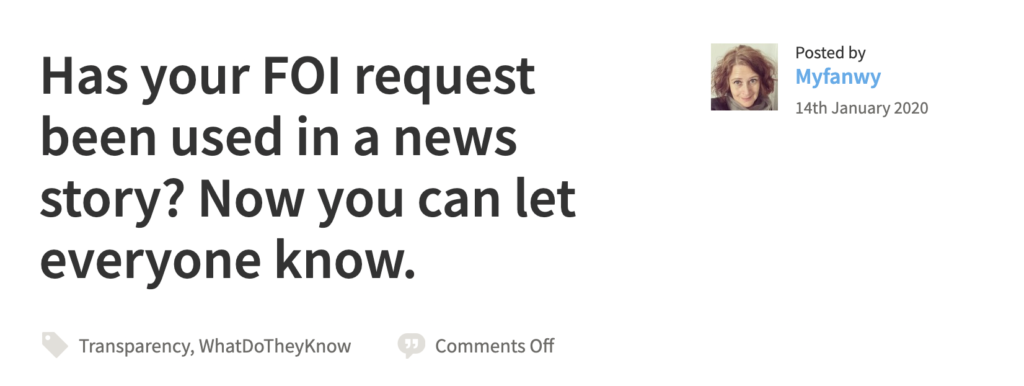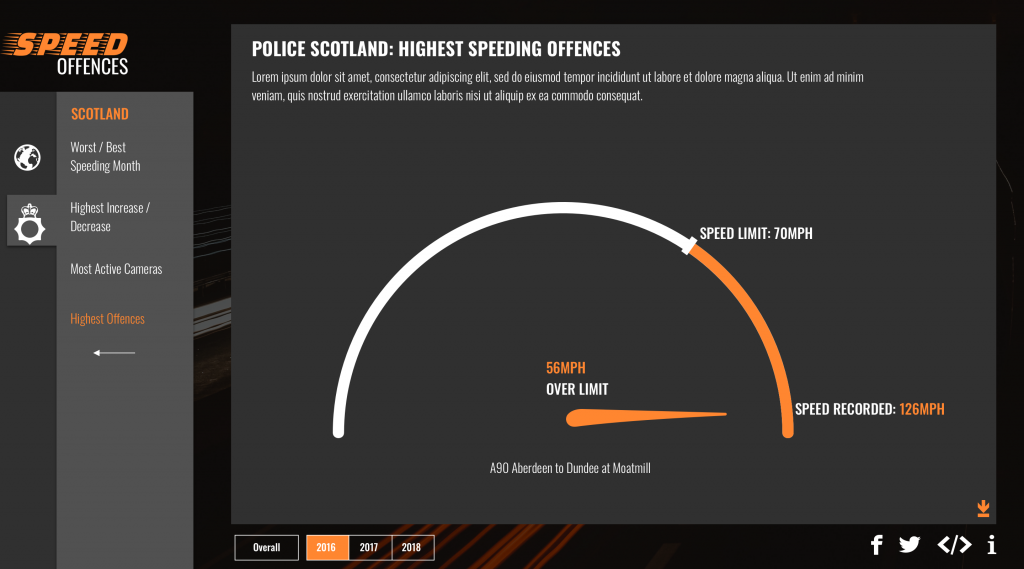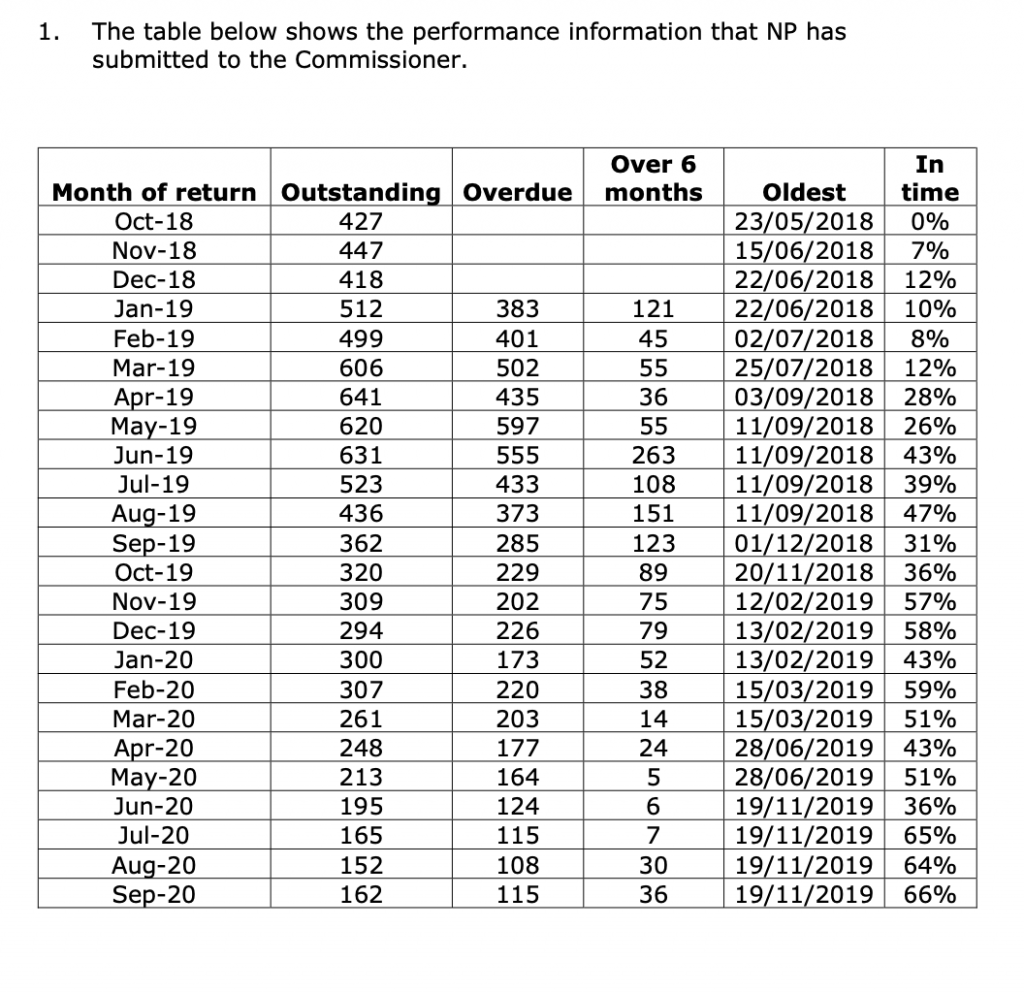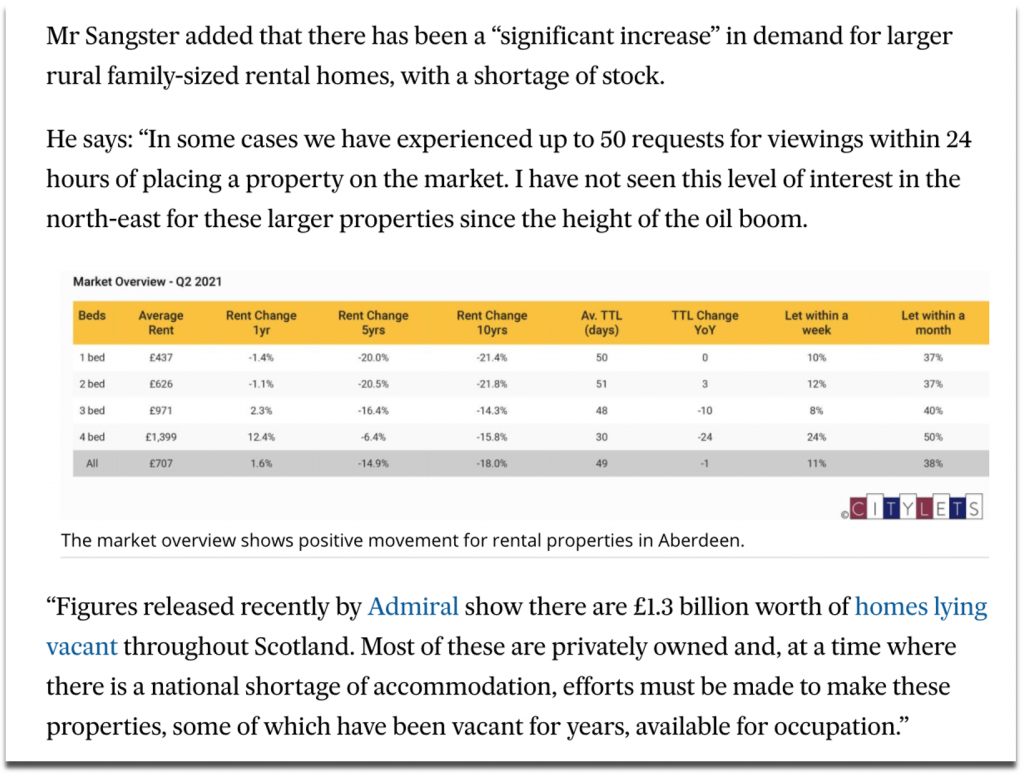A Freedom of Information request that is constructed out of uniform questions with measurable answers can build content that earns press coverage on a large scale, both geographically and across the various news topics it can cover.
The Freedom of Information Act enables any member of the public to uncover information that otherwise may not have been released to the public.
The law applies to more than 100,000 public bodies in the United Kingdom, meaning there are lots of stories out there to be told by using the law to access data.
In this post I’ll talk through various aspects of using the UK’s Freedom of Information Act as part of a content and outreach strategy that is built for earning links via press coverage, including:
- What the FOI Act is
- Where to find inspiration for stories
- Tips on requesting the right information
- Some pitfalls to avoid
1. What is the Freedom of Information Act?
Introduced in the UK in 2000, it is the right to know information about publicly owned organisations. The Act places two main responsibilities on those public authorities: a) to confirm whether they hold information, and b) to disclose that information to the person who asked for it.
Some bodies that you might expect to be covered by the Act are exempt. These include housing associations for the most part, security bodies such as MI5, and the royal family – so you won’t be able to find out how much of the taxpayer’s money the queen spends on her breakfast anytime soon.
Despite their public status, it’s also tricky to obtain anything especially useful from the BBC, as most of their interesting data seems to be protected internally “for the purposes of journalism, art or literature”.
 Tip
Tip
The FOI Act also committed public authorities to regular publication schemes, meaning organisations now publish information much more proactively than they did before. This may not seem as valuable as asking for exclusive information yourself, but it’s surprising how much useful data these publications can already provide, without having to send a request. Take a look at the UK Police Force’s open data portal, for example, and you’ll already find crime data regularly published at a constabulary level.
2. Where to find inspiration for stories
If you send a quick general enquiry email to the first public organisation that you can think of, you might be disappointed to find that your request was rejected after waiting 20 working days for a response. Take a look at some of the below recommendations, which will provide inspiration for potential stories, and possibly be able to tell you if the information you seek is available at all.
WhatDoTheyKnow
Some organisations, such as the Office for National Statistics, will publish FOI requests that were made to them and responded to directly on their website. For those that don’t, WhatDoTheyKnow is the most useful way of accessing previous requests made to UK organisations.
Study examples that did and didn’t work by filtering your search by ‘successful’ or ‘unsuccessful’ requests. Doing so will potentially save you a lot of time with having to clarify your FOI request further down the line.
Another useful feature that was recently rolled out on this platform allows users to add any examples of their request being used in a news story as a citation. Look out for these citations, as they can help to inform your outreach strategy to a greater extent by seeing how certain FOI requests convert into news headlines.

WhatDoTheyKnow also allows you to make requests through their platform and includes a guide for beginners on how to request information. Requests can also be made through your own company email address or private email address.
Google News search: “Freedom of information”
When seeking inspiration for stories, sometimes a simple Google search can be just as useful as pouring through the specifics of WhatDoTheyKnow. Type in “freedom of information” and browse through the many ways in which UK and international journalists are utilising the law to produce public interest news stories.
Taking the time to read these articles from top to bottom will also show how many metrics journalists may report on for a particular type of story, as well as showing the kinds of spokespeople you can seek out within that sector to comment on your findings later on.
Doing this also presents the potential to scale up an interesting local story into something national that can be compared across different parts of the country. Did the Manchester Evening News publish their own FOI-led story about car parking fines? There’s a good chance that if it makes headlines in Manchester, a similar piece will make headlines elsewhere too.
The organisation’s website
If you have an organisation in mind, but you’re not sure whether they hold the information you want, take the time to browse through its website; specifically their services, publications and type of user data they retrieve. By the time you’ve read through these sections you will have a much better idea of what data you could ask for, and how this could convert into an idea for a story.
For example, OFCOM are one organisation covered by the Freedom of Information Act, and if you didn’t know what they do already, it doesn’t take long to see from their website that you can access data about public complaints related to TV, radio and other UK broadcasting services.
The BBC Shared Data Unit
The BBC Shared Data Unit is a nationwide partnership between the BBC and News Media Association that previously won ‘Editorial Innovation of the Year’ at The Drum Online Media Awards. It is dedicated to sharpening the data skills of journalists in local newsrooms around the UK and producing stories that work at scale for various regional and local titles.
Much of their data work is sourced from FOI requests, and, similar to how Digital PR campaigns aim to include angles that appeal to as many newspapers as possible, the Shared Data Unit is an excellent example of how to produce a story that resonates throughout the UK by picking out the angles from a larger dataset to make them work for local readerships. Here is one of my favourite examples of theirs:

A story that found British football matches were being heavily over-policed at a significant financial cost to the taxpayer.
The journalists behind this story compared information that they requested of police constabularies around the country with match attendance data from Opta, allowing them to rank ‘number of fans per officer’. It went on to generate 18 unique pieces of coverage in different newspapers within six days — not bad, considering Digital PR isn’t their game!
Like all good data storytelling, the Shared Data Unit is transparent with its methodologies and data. I would recommend reading through these if you’re just starting out on a larger FOI project for the first time, to see how they go about their process, from research and data interpretation, right through to execution and coverage.
3. Tips on requesting information
Think like a: marketer investigative journalist
curious citizen
Understanding what kind of information you can obtain doesn’t mean that you need to be an expert in coming up with ideas for data-led stories. Neither does it mean that you have to be wearing a Pulitzer Prize-winning cap in the hope of exposing the next great national scandal.
Some of the most effective FOI-led stories ask straightforward questions that the average citizen would be concerned with knowing and reading about, and which the person managing your request can easily interpret to collect data from their organisation.
 Tip
Tip
Stories about dangerous drivers, public expenses, housing issues or crime rates are just some of the topics that resonate emotionally with the average Brit. You can explore all of these topics through a targeted FOI request.
Simplicity with this in mind is important. While it’s noble to try to expose a brand new category of information from a public organisation that hasn’t been released before, the time constraints of your campaign’s production may risk leading you to spend more time contesting complicated and unsuccessful requests with the Information Commissioner’s Officer (ICO) instead of gathering straightforward, consistent data.
If you’ve already committed to the sign-off and kick-off of your idea without sending any test requests, then general enquiries or ‘fishing’ for information that you’re unsure is held shouldn’t be making up the crux of your FOI request at this point.
Including a speculative question alongside a set of questions that you know will be answered would at least guarantee that the majority of your request will be fruitful.
Whereas tentatively fishing for unknown types of information and expecting completely useable answers can easily end in wasted time and resources on your side and on the organisation’s side. More on this further down in the ‘potential pitfalls’.
Scale it geographically
Typically, FOI-led stories about UK organisations are less likely to appeal to non-UK journalists or publications.
You must consider how many organisations need to be contacted in order to produce a comprehensive story, and whether the work you put in will even deliver a large enough pool of outreach prospects.
 Tip
Tip
Taking your FOI requests global (i.e. contacting organisations outside of the UK) will add a new layer of complexity to your research, which I won’t cover in this post. For more information on how you can work with FOI laws in other countries, click here.
A campaign we produced for Admiral in 2019 and 2021 looked at the scale of the empty homes crisis in Britain, and provided us with perhaps the most granular list of UK-based outreach prospects that we could hope for.

The housing crisis, of which empty homes are a symptom, is engulfing the whole country. Therefore it was necessary to ask every British council for the same information in order to be able to compare the luxury districts of London and holiday home hotspots of Cornwall to other parts of Britain.
You don’t necessarily need to contact every council for every idea that considers information from them. This campaign produced by CompareMyMove looked at where in the UK registered the most noise complaints, and decided to focus on the most populated towns and cities. For an idea that ranked noise, focussing on places where a lot of people live made sense and didn’t necessarily require more rural (and typically quieter) districts to be considered.
You will find some organisations only have one central contact that stores all of its localised data, which means you would only need to ask for the same data once and specify that it should be broken down locally.
Some of the coverage from our Testing Times campaign for GoCompare leaned on an FOI response to our question on ‘multiple testers’ (i.e. those who need 5 or more attempts to pass), as well as open data from the Dept. for Transport and a survey that revealed demographic and geographic breakdowns of claims and convictions.

To reveal the hardest test centres for passing a driving test, the DVLA (Driver and Vehicle Licensing Agency) held this information centrally, meaning we obtained all of the local data we needed from a single FOI request.
Scale it with data points
A common method in campaigns built for link building and digital PR is to rank different metrics related to locations that are covered by news publishers. This presents the opportunity to outreach to those publishers and acknowledge that their locality ranks particularly high or low on certain measures.
While an FOI-led analysis that compares different locations on certain measures will still reveal the highest and lowest ranks in the same way, you can also build out a comprehensive story that works for all of the locations that you are including in your dataset by considering ‘the state of play’ in those areas.
For example, the TV Tribulations campaign that we created for Buzz Bingo analysed complaints made to OFCOM and revealed which parts of the UK complain about television shows the most.

Even newspapers based in locations that didn’t rank highly on a national level were able to cover the campaign as we were able to provide data on their 10 most complained-about TV shows, plus how many complaints were made by that area over a given time period. It didn’t matter whether or not they were the highest ranking in the UK.

And in terms of outreach prospects, the data points were able to be split in a way that appealed to different sectors as well as different regions. Digging into the raw data of our TV complaints allowed us to reveal ‘the most complained-about radio show’ as well as ‘the most complained-about sports teams’.

Once you’re confident that your data is available, you can ask a number of related questions that will make for a more comprehensive dataset, and which may include outliers that wouldn’t have been discovered by only asking one broad question.
For example, depending on how sensitive the information is, you may be able to ask for more specific street-level figures rather than just a figure for an entire local authority, as we did in this GoCompare campaign called Speed Offences. This told us which roads record the most speeding offences per year (locally and nationally). Again, doing this creates an interesting story to be told for every locality, not just the outliers.
Other angles we built into this campaign included: the highest speeding offences recorded and the worst months for speeding, simply by asking for specific breakdowns.

4. Potential pitfalls
Check for ambiguity
Accurate language is essential when crafting an FOI request.
If your request isn’t clear, it can be the difference between receiving the information you need in 40 working days rather than 20 days (after you’ve had to provide a clarification), or never.
If your request is misinterpreted and you receive the wrong kind of data, it may well be unusable and require a second request anyway.
Word the request exactly how you want the information to be delivered to you.
Describe how it should be measured, what period of time you would like it to be for, and how that time period should be split (daily, monthly, yearly?).
Oh, and specify the format. The last thing you need when compiling your responses are more than 400 councils replying with PDFs and Word Docs of data.
Consider the cost and limitations
This might seem slightly contradictory to what I mentioned about scaling up the number of angles you want to include, but you should consider the limitations of the FOI Act.
The cost limit of a request is £600 (equivalent to 24 hours of work) from a central government department, and £450 from local authorities (equivalent to 18 hours of work).
If your request is estimated by the organisation to exceed what is known as the “appropriate limit”, certain sections of the request will be refused. If your request consists of one or two questions that demand substantial work, the request may be refused outright.
If you know the data you are asking for is recorded by them, or better yet, you have done your research and seen evidence of it being published already, then the work involved in retrieving the data should fall within the cost limit.
 Tip
Tip
There are more exemptions that apply to the Act, which you can read about here.
Plan ahead by sending a tester email
An FOI-led campaign can be quite a time commitment. Planning further ahead by sending an email to an organisation that asks if they have the information available is a useful step for if you want to uncover a more unique story that hasn’t been published before, but which you suspect is available from them.
Taking a longer term approach to this method of research will also give you an idea of how reliable certain organisations are in responding on time. Regardless of how much you do test in advance, a 100% response rate is unlikely to arrive within the 20-working day period that it’s supposed to.
The example below from the ICO shows that between October 2018 and September 2020, Northamptonshire Police only managed to answer a maximum of 66% of their requests on time in a single calendar month. Response success rates vary among all organisations, and you can expect them to vary from month to month within each organisation.

Sending tester emails further ahead would also help for you to gauge whether the information you seek is consistently measured by similar organisations. An email to a handful of universities, for example, should tell you if they record certain data on their students in the same way, before you embark on a full investigation.
Be proactive in monitoring your responses
You’re probably blessed with more research time than the average online journalist, who is busy producing upwards of eight or more articles per day. This means that your FOI-led story could be something they wouldn’t have had the capacity to produce themselves.
Equally, you’re almost certainly not blessed with as much time and autonomy as an investigative journalist, who can press the ICO for months until they receive their satisfactory response, and it’s important to remember this during the process.
Say you’ve embarked on a round-robin FOI request, and contacted all 130 UK Universities in the UK. There’s a reasonably high chance that at least a handful of them will misinterpret your request, seek clarification, or respond beyond the 20-working day timeframe — in this case, you’d be relying on at least 130 different people to get back to you with the same information in the same format.
In the interests of deadlines, sometimes you have to cut your losses on the information that didn’t arrive. At the same time, you need to closely monitor the story that is accumulating in front of you, and decide whether there is a story there at all.
Generally speaking, a two-thirds rule of responses with consistent data would be adequate for producing an analysis of UK Universities, with clarification of how many didn’t respond, but it really does depend on what you’re comparing and what the sample size of organisations is. The data that is missing could well be more valuable in constructing a story than the data that you did receive.
Seek comments and anticipate a PR response
By its very definition, the data that you’re dealing with is authoritative and within the public interest, so don’t be surprised when organisations and public figures acknowledge it and often respond to it when it concerns them. Below is one notable example…
But responses are often concerned with more serious topics of public interest, such as when our empty homes valuation was quoted by a local property agent when commenting on Aberdeen’s local housing issues.

Since releasing FOI-led stories and following the news coverage they receive, we’ve dealt with phone calls from a number of press offices, including NHS Trusts, councils and cultural institutions, all of whom have wanted to find out more about the data they originally sent to us.
If the main headlines that emerge from your data can be attributed to an individual or a small number of organisations, then it’s worth reaching out to them to comment. Even though a journalist will typically contact the public organisations to comment before publishing their story, doing this yourself adds valuable context and commentary to your research.
Why is your brand doing this?
This is a question that should be asked of any potential idea that is going to be published and outreached for your clients.
In the case of FOI requests, as soon as you produce content that is built on information from public bodies and take those stories to the press, the brand you’re outreaching for is influencing the reputation of other people and organisations.
Some topics may seem relevant enough to approach from a storytelling perspective in order to earn coverage for a client, but public data is sensitive and often gets politicised.
The client that you work with should be made aware of potential backlashes to an FOI-led story before an idea is deemed appropriate for them.
Further reading and people to follow:
- How to access information from a public body [1]
- What is public interest journalism? [2]
- Research and where to find data for your campaign by Hana Bednarova [3]
- Twitter.com/FOImanUK: Information Rights Practitioner and Author of The Freedom of Information Officer’s Handbook
- Twitter.com/mattburgess1: Author of the Freedom of Information handbook
Interested in our content marketing and digital PR services? Get in touch.






